Polymorphisms in Genes Encoding VDR, CALCR and Antioxidant Enzymes as Predictors of Bone Tissue Condition in Young, Healthy Men
Abstract
1. Introduction
2. Results
3. Discussion
4. Material and Methods
4.1. Subjects
4.2. BMC and BMD Measurements
4.3. Blood Sampling and Biochemical Analyses
4.4. Genotyping
4.5. Statistical Analysis
5. Conclusions
Supplementary Materials
Author Contributions
Funding
Institutional Review Board Statement
Informed Consent Statement
Data Availability Statement
Acknowledgments
Conflicts of Interest
Abbreviations
| 25-OH D | 25-OH vitamin D |
| ALP | alkaline phosphatase |
| BMC | bone mineral content |
| BMD | bone mineral density |
| Ca | calcium |
| CALCR | receptor of calcitonin |
| COLIA1 | collagen type I |
| GPx | glutathione peroxidase |
| LOOHs | lipid hydroperoxides |
| MMA | mixed martial arts |
| OC | osteocalcin |
| P | phosphates |
| SOD1 | supeoxide dismutase 1 |
| SOD2 | superoxide dismutase 2 |
| T | testosterone |
| TAC | total antioxidant capacity |
| UA | uric acid |
| VDR | vitamin D receptor |
References
- Khosla, S.; Amin, S.; Orwoll, E. Osteoporosis in men. Endocr. Rev. 2008, 29, 441–464. [Google Scholar] [PubMed]
- Arazi, H.; Eghbali, E. Effects of Different Types of Physical Training on Bone Mineral Density in Men and Women. J. Osteopor. Phys. Act. 2017, 5, 3. [Google Scholar] [CrossRef]
- Gentil, P.; de Lima Lins, T.C.; Lima, R.M.; de Abreu, B.S.; Grattapaglia, D.; Bottaro, M.; de Oliveira, R.J.; Pereira, R.W. Vitamin-d-receptor genotypes and bone-mineral density in postmenopausal women: Interaction with physical activity. J. Aging Phys. Act. 2009, 17, 31–45. [Google Scholar] [CrossRef] [PubMed]
- Ruffing, J.A.; Cosman, F.; Zion, M.; Tendy, S.; Garrett, P.; Lindsay, R.; Nieves, J.W. Determinants of bone mass and bone size in a large cohort of physically active young adult men. Nutr. Metab. 2006, 3, 14. [Google Scholar] [CrossRef] [PubMed]
- Walsh, J.S. Normal bone physiology, remodelling and its hormonal regulation. Surgery 2015, 33, 1–6. [Google Scholar] [CrossRef]
- Ocarino, N.M.; Serakides, R. Effect of the physical activity on normal bone and on the osteoporosis prevention and treatment. Rev. Bras. Med. Esporte 2006, 12, 164–168. [Google Scholar] [CrossRef]
- Tong, X.; Chen, X.; Zhang, S.; Huang, M.; Shen, X.; Xu, J.; Zou, J. The Effect of Exercise on the Prevention of Osteoporosis and Bone Angiogenesis. Biomed. Res. Int. 2019, 2019, 8171897. [Google Scholar] [CrossRef]
- Hinrich, T.; Chae, E.H.; Lehmann, R.; Allolio, B.; Platen, P. Bone Mineral Density in Athletes of Different Disciplines: A Cross Sectional Study. Open Sport. Sci. J. 2010, 3, 129–133. [Google Scholar] [CrossRef]
- Długołęcka, B.; Jówko, E. Effects of Weight-Bearing and Weight-Supporting Sports on Bone Mass in Males. Pol. J. Sport Tour. 2022, 29, 9–14. [Google Scholar] [CrossRef]
- Ralston, S.H.; de Crombrugghe, B. Genetic regulation of bone mass and susceptibility to osteoporosis. Genes Dev. 2006, 20, 2492–2506. [Google Scholar] [CrossRef]
- Zhang, L.; Yin, X.; Wang, J.; Xu, D.; Wang, Y.; Yang, J.; Tao, Y.; Zhang, S.; Feng, X.; Yan, C. Associations between VDR gene polymorphisms and osteoporosis risk and bone mineral density in postmenopausal women: A systematic review and meta-analysis. Sci. Rep. 2018, 8, 981. [Google Scholar] [CrossRef] [PubMed]
- Kow, M.; Akam, E.; Singh, P.; Singh, M.; Cox, N.; Bhatti, J.S.; Tuck, S.P.; Francis, R.M.; Datta, H.; Mastana, S. Vitamin D receptor (VDR) gene polymorphism and osteoporosis risk in White British men. Ann. Hum. Biol. 2019, 46, 430–433. [Google Scholar] [CrossRef] [PubMed]
- Masi, L.; Brandi, M.L. Calcitonin and calcitonin receptors. Clin. Cases Miner. Bone Metab. 2007, 4, 117–122. [Google Scholar] [PubMed]
- Braga, V.; Sangalli, A.; Malerba, G.; Mottes, M.; Mirandola, S.; Gatti, D.; Rossini, M.; Zamboni, M.; Adami, S. Relationship among VDR (BsmI and FokI), COLIA1, and CTR polymorphisms with bone (BsmI and FokI), COLIA1, and CTR polymorphisms with bone mass, bone turnover markers, and sex hormones in men. Calcif. Tissue Int. 2002, 70, 457–462. [Google Scholar] [CrossRef] [PubMed]
- Charopoulos, I.; Trovas, G.; Stathopoulou, M.; Kyriazopoulos, P.; Galanos, A.; Dedoussis, G.; Antonogiannakis, E.; Lyritis, G.P. Lack of association between vitamin D and calcitonin receptor gene polymorphisms and forearm bone values of young Greek males. J. Musculoskelet. Neuronal Interact. 2008, 8, 196–203. [Google Scholar] [PubMed]
- Wu, J.; Yu, M.; Zhou, Y. Association of collagen type I alpha 1 +1245G/T polymorphism and osteoporosis risk in post-menopausal women: A meta-analysis. Int. J. Rheum. Dis. 2017, 20, 903–910. [Google Scholar] [CrossRef]
- Nakamura, O.; Ishii, T.; Ando, Y.; Amagai, H.; Oto, M.; Imafuji, T.; Tokuyama, K. Potential role of vitamin D receptor gene polymorphism in determining bone phenotype in young male athletes. J. Appl. Physiol. 2002, 93, 1973–1979. [Google Scholar] [CrossRef]
- Puthucheary, Z.; Skipworth, J.R.; Rawal, J.; Loosemore, M.; Van Someren, K.; Montgomery, H.E. Genetic influences in sport and physical performance. Sports Med. 2011, 41, 845–859. [Google Scholar] [CrossRef]
- Maggio, D.; Barabani, M.; Pierandrei, M.; Polidori, M.C.; Catani, M.; Mecocci, P.; Senin, U.; Pacifici, R.; Cherubini, A. Marked decrease in plasma antioxidants in aged osteoporotic women: Results of a cross-sectional study. J. Clin. Endocrinol. Metabol. 2003, 88, 1523–1537. [Google Scholar] [CrossRef]
- Botre, C.; Shahu, A.; Adkar, N.; Shouche, Y.; Ghaskadbi, S.; Ashma, R. Superoxide Dismutase 2 Polymorphisms and Osteoporosis in Asian Indians: A Genetic Association Analysis. Cell Mol. Biol. Lett. 2015, 20, 685–697. [Google Scholar] [CrossRef]
- Zhang, Y.B.; Zhong, Z.M.; Hou, G.; Jiang, H.; Chen, J.T. Involvement of oxidative stress in age-related bone loss. J. Surg. Res. 2011, 169, 37–42. [Google Scholar] [CrossRef] [PubMed]
- Sánchez-Rodríguez, M.A.; Ruiz-Ramos, M.; Correa-Muñoz, E.; Mendoza-Núñez, V.M. Oxidative stress as a risk factor for osteoporosis in elderly Mexicans as characterized by antioxidant enzymes. BMC Musculoskelet. Disord. 2007, 8, 124. [Google Scholar] [CrossRef] [PubMed]
- Bastaki, M.; Huen, K.; Manzanillo, P.; Chande, N.; Chen, C.; Balmes, J.R.; Tager, I.B.; Holland, N. Genotype-activity relationship for Mn-superoxide dismutase, glutathione peroxidase 1 and catalase in humans. Pharmacogenet. Genom. 2006, 16, 279–286. [Google Scholar] [CrossRef] [PubMed]
- Bresciani, G.; Cruz, I.B.; de Paz, J.A.; Cuevas, M.J.; Gonzalez-Gallego, J. The MnSOD Ala16Val SNP: Relevance to human diseases and interaction with environmental factors. Free Rad. Res. 2013, 47, 781–792. [Google Scholar] [CrossRef] [PubMed]
- Mlakar, S.J.; Osredkar, J.; Prezelj, J.; Marc, J. The antioxidant enzyme GPX1 gene polymorphisms are associated with low BMD and increased bone turnover markers. Dis. Markers 2010, 29, 71–80. [Google Scholar] [CrossRef]
- Mlakar, S.J.; Osredkar, J.; Prezelj, J.; Marc, J. Antioxidant enzymes GSR, SOD1, SOD2, and CAT gene variants and bone mineral density values in postmenopausal women: A genetic association analysis. Menopause 2012, 19, 368–376. [Google Scholar] [CrossRef] [PubMed]
- Gomez-Cabrera, M.C.; Domenech, E.; Viña, J. Moderate exercise is an antioxidant: Upregulation of antioxidant genes by training. Free Radic. Biol. Med. 2008, 44, 126–131. [Google Scholar] [CrossRef] [PubMed]
- Hagman, M. Bone mineral density in lifelong trained male football players compared with young and elderly untrained men. J. Sport Health Sci. 2018, 7, 159–168. [Google Scholar] [CrossRef]
- Cadore, E.L.; Brentano, M.A.; Kruel, L.F.M. Effects of the physical activity on the bone mineral density and bone remodelation. Rev. Bras. Med. Esporte 2005, 11, 373–379. [Google Scholar] [CrossRef]
- Fragala, M.S.; Bi, C.; Chaump, M.; Kaufman, H.W.; Kroll, M.H. Associations of aerobic and strength exercise with clinical laboratory test values. PLoS ONE 2017, 12, e0180840. [Google Scholar] [CrossRef]
- Jówko, E.; Gromisz, W.; Sadowski, J.; Cieśliński, I.; Kotowska, J. SOD2 gene polymorphism may modulate biochemical responses to a 12-week swimming training. Free Rad. Biol. Med. 2017, 113, 571–579. [Google Scholar] [CrossRef] [PubMed]
- Jówko, E.; Gierczuk, D.; Cieśliński, I.; Kotowska, J. SOD2 gene polymorphism and response of oxidative stress parameters in young wrestlers to a three-month training. Free Rad. Res. 2017, 51, 506–516. [Google Scholar]
- Crawford, A.; Fassett, R.G.; Geraghty, D.P.; Kunde, D.A.; Ball, M.J.; Robertson, I.K.; Coombes, J.S. Relationships between single nucleotide polymorphisms of antioxidant enzymes and disease. Gene 2012, 501, 89–103. [Google Scholar] [PubMed]
- Ravn-Haren, G.; Olsen, A.; Tjønneland, A.; Dragsted, L.O.; Nexø, B.A.; Wallin, H.; Overvad, K.; Raaschou-Nielsen, O.; Vogel, U. Associations between GPX1 Pro198Leu polymorphism, erythrocyte GPX activity, alcohol consumption and breast cancer risk in a prospective cohort study. Carcinogenesis 2006, 27, 820–825. [Google Scholar] [CrossRef] [PubMed]
- Wickremasinghe, D.; Peiris, H.; Chandrasena, L.G.; Senaratne, V.; Perera, R. Case control feasibility study assessing the association between severity of coronary artery disease with Glutathione Peroxidase-1 (GPX-1) and GPX-1 polymorphism (Pro198Leu). BMC Cardiovasc. Disord. 2016, 16, 111. [Google Scholar] [CrossRef] [PubMed]
- Kotowska, J.; Jówko, E. Effect of Gene Polymorphisms in Antioxidant Enzymes on Oxidative-Antioxidative Status in Young Men. Pol. J. Sport Tour. 2020, 27, 7–13. [Google Scholar] [CrossRef]
- Mohammadi, Z.; Fayyazbakhsh, F.; Ebrahimi, M.; Amoli, M.M.; Khashayar, P.; Dini, M.; Zadeh, R.N.; Keshtkar, A.; Barikani, H.R. Association between vitamin D receptor gene polymorphisms (Fok1 and Bsm1) and osteoporosis: A systematic review. J. Diabetes Metab. Disord. 2014, 13, 98. [Google Scholar] [CrossRef]
- Goolsby, M.A.; Boniqui, N. Bone Health in Athletes. Sports Health 2017, 9, 108–117. [Google Scholar]
- Jagtap, V.R.; Ganu, J.V. Serum osteocalcin: A specific marker for bone formation in postmenopausal osteoporosis. Int. J. Pharm. Bio. Sci. 2011, 1, 510–517. [Google Scholar]
- Alghadir, A.H.; Gabr, S.A.; Al-Eisa, E. Physical activity and lifestyle effects on bone mineral density among young adults: Sociodemographic and biochemical analysis. J. Phys. Ther. Sci. 2015, 27, 2261–2270. [Google Scholar]
- Szulc, P.; Delmas, P.D. Biochemical Markers of Bone Turnover in Osteoporosis. In Osteoporosis, 3rd ed.; Chapter 63; Marcus, R., Feldman, D., Nelson, D., Rosen, C., Eds.; Academic Press, Elsevier Inc.: Cambridge, MA, USA, 2008; pp. 1519–1545. [Google Scholar]
- Cashman, K.D.; Hill, T.R.; Cotter, A.A.; Boreham, C.A.; Dubitzky, W.; Murray, L.; Strain, J.; Flynn, A.; Robson, P.J.; Wallace, J.M.; et al. Low vitamin D status adversely affects bone health parameters in adolescents. Am. J. Clin. Nutr. 2008, 87, 1039–1044. [Google Scholar] [CrossRef] [PubMed]
- Ames, S.K.; Ellis, K.J.; Gunn, S.K.; Copeland, K.C.; Abrams, S.A. Vitamin D receptor gene FokI polymorphism predicts calcium absorption and bone mineral density in children. J. Bone Miner. Res. 1999, 14, 740–746. [Google Scholar]
- Tanabe, R.; Kawamura, Y.; Tsugawa, N.; Haraikawa, M.; Sogabe, N.; Okano, T.; Hosoi, T.; Goseki-Sone, M. Effects of Fok-I polymorphism in vitamin D receptor gene on serum 25-hydroxyvitamin D, bone-specific alkaline phosphatase and calcaneal quantitative ultrasound parameters in young adults. Asia Pac. J. Clin. Nutr. 2015, 24, 329–335. [Google Scholar] [PubMed]
- Laaksonen, M.M.; Kärkkäinen, M.U.; Outila, T.A.; Rita, H.J.; Lamberg-Allardt, C.J. Vitamin D receptor gene start codon polymorphism (FokI) is associated with forearm bone mineral density and calcaneal ultrasound in Finnish adolescent boys but not in girls. J. Bone Miner. Metab. 2004, 22, 479–485. [Google Scholar]
- Strandberg, S.; Nordström, P.; Lorentzon, R.; Lorentzon, M. Vitamin D receptor start codon polymorphism (FokI) is related to bone mineral density in healthy adolescent boys. J. Bone Miner. Metab. 2003, 21, 109–113. [Google Scholar] [CrossRef]
- Tajima, O.; Ashizaw, N.; Ishii, T.; Amagai, H.; Mashimo, T.; Liu, L.J.; Saitoh, S.; Tokuyama, K.; Suzuki, M. Interaction of the effects between vitamin D receptor polymorphism and exercise training on bone metabolism. J. Appl. Physiol. 2000, 88, 1271–1276. [Google Scholar] [CrossRef]
- Rabon-Stith, K.M.; Hagberg, J.M.; Phares, D.A.; Kostek, M.C.; Delmonico, M.J.; Roth, S.M.; Ferrell, R.E.; Conway, J.M.; Ryan, A.S.; Hurley, B.F. Vitamin D receptor FokI genotype influences bone mineral density response to strength training, but not aerobic training. Exp. Physiol. 2005, 90, 653–661. [Google Scholar] [CrossRef]
- Diogenes, M.E.; Bezerra, F.F.; Cabello, G.M.; Cabello, P.H.; Mendonça, L.M.; Oliveira, A.V., Jr.; Donangelo, C.M. Vitamin D receptor gene FokI polymorphisms influence bone mass in adolescent football (soccer) players. Eur. J. Appl. Physiol. 2010, 108, 31–38. [Google Scholar] [CrossRef]
- Dehghan, M.; Pourahmad-Jaktaji, R.; Farzaneh, Z. Calcitonin Receptor AluI (rs1801197) and Taq Calcitonin Genes Polymorphism in 45-and Over 45-year-old Women and their Association with Bone Density. Acta Inform. Med. 2016, 24, 239–243. [Google Scholar] [CrossRef]
- Taboulet, J.; Frenkian, M.; Frendo, J.L.; Feingold, N.; Jullienne, A.; de Vernejoul, M.C. Calcitonin receptor polymorphism is associated with a decreased fracture risk in post-menopausal women. Hum. Mol. Genet. 1998, 7, 2129–2133. [Google Scholar] [CrossRef] [PubMed]
- Gérard-Monnier, D.; Erdelmeier, I.; Régnard, K.; Moze-Henry, N.; Yadan, J.C.; Chaudière, J. Reactions of N-methyl-2-phenylindole with malondialdehyde and 4-hydroxyalkenals. Mechanistic aspects of the colorimetric assay of lipid peroxidation. Chem. Res. Toxicol. 1998, 11, 1176–1183. [Google Scholar] [CrossRef] [PubMed]
- Graffelman, J. Exploring Diallelic Genetic Markers: The Hardy Weinberg Package. J. Stat. Softw. 2015, 64, 1–23. [Google Scholar]
- Biecek, P. Analiza Danych z Programem R. Modele Liniowe z Efektami Stałymi, Losowymi i Mieszanymi; Wydawnictwo Naukowe PWN: Warsaw, Poland, 2013. (In Polish) [Google Scholar]
- Meyer, D.; Dimitriadou, E.; Hornik, K.; Weingessel, A.; Leisch, F. Misc Functions of the Department of Statistics, Probability Theory Group (Formerly: E1071); R Package Version 1.7-3. 2019, e1071; TU Wien: Vienna, Austria, 2023; Available online: https://CRAN.R-project.org/package=e1071 (accessed on 5 December 2019).

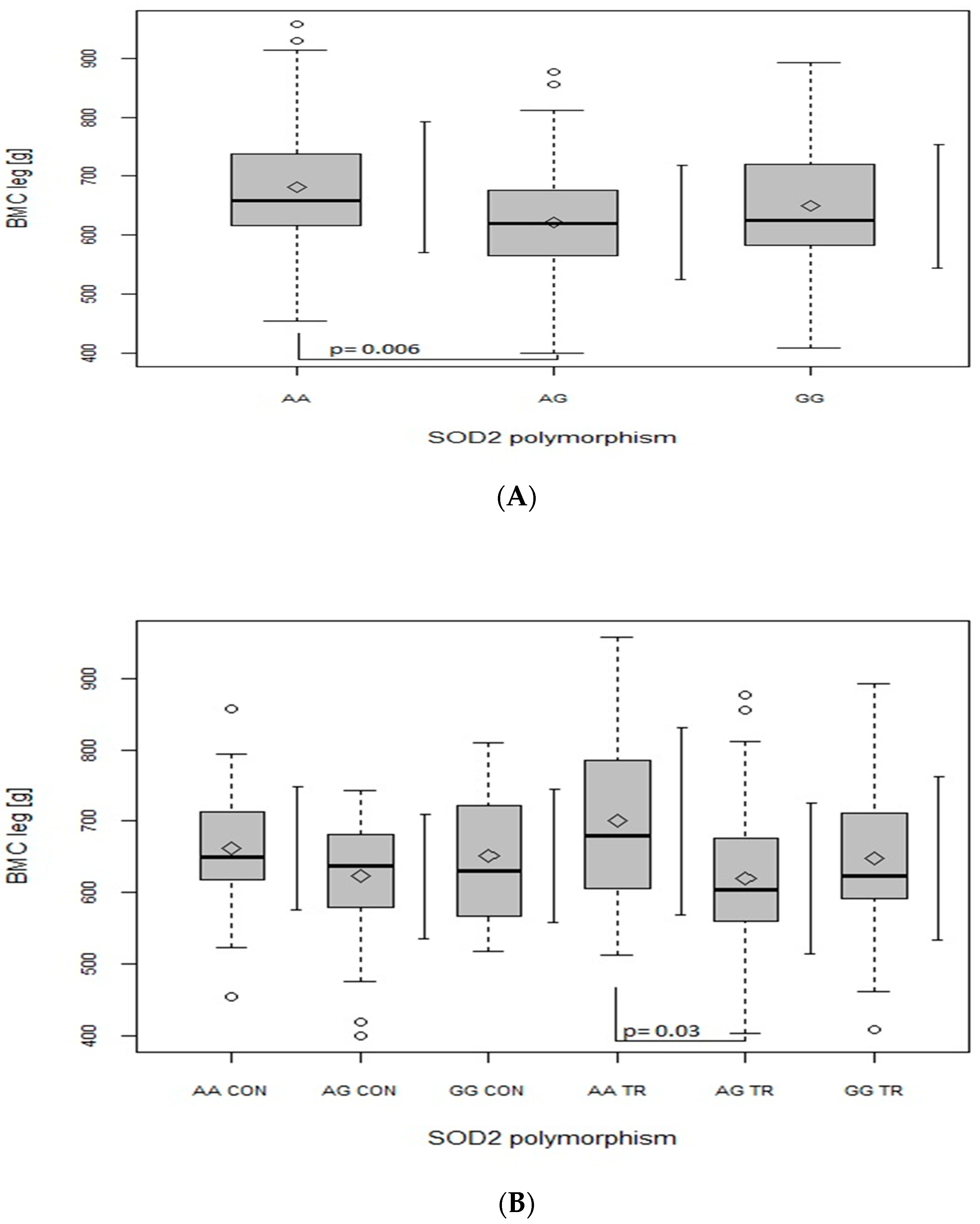
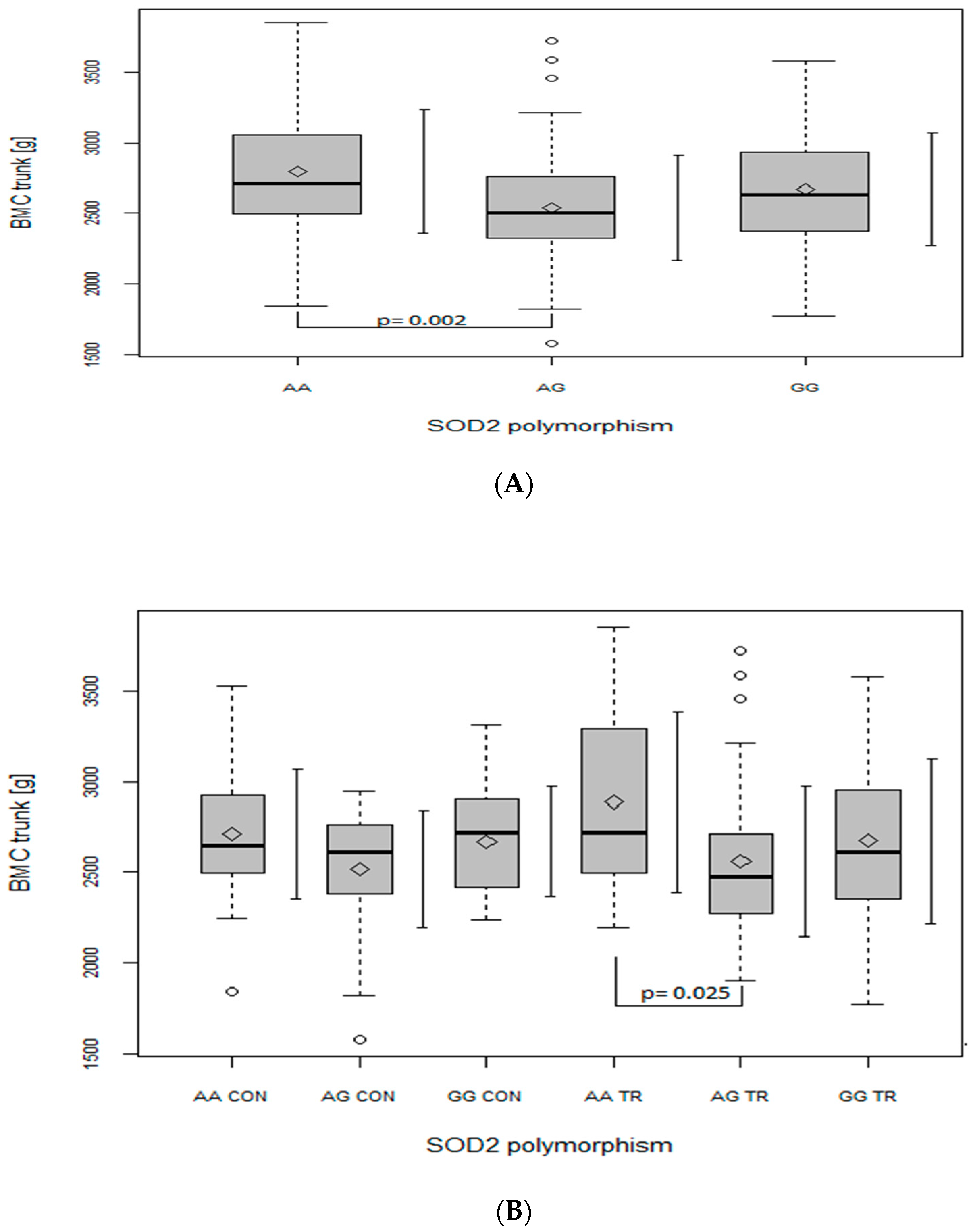
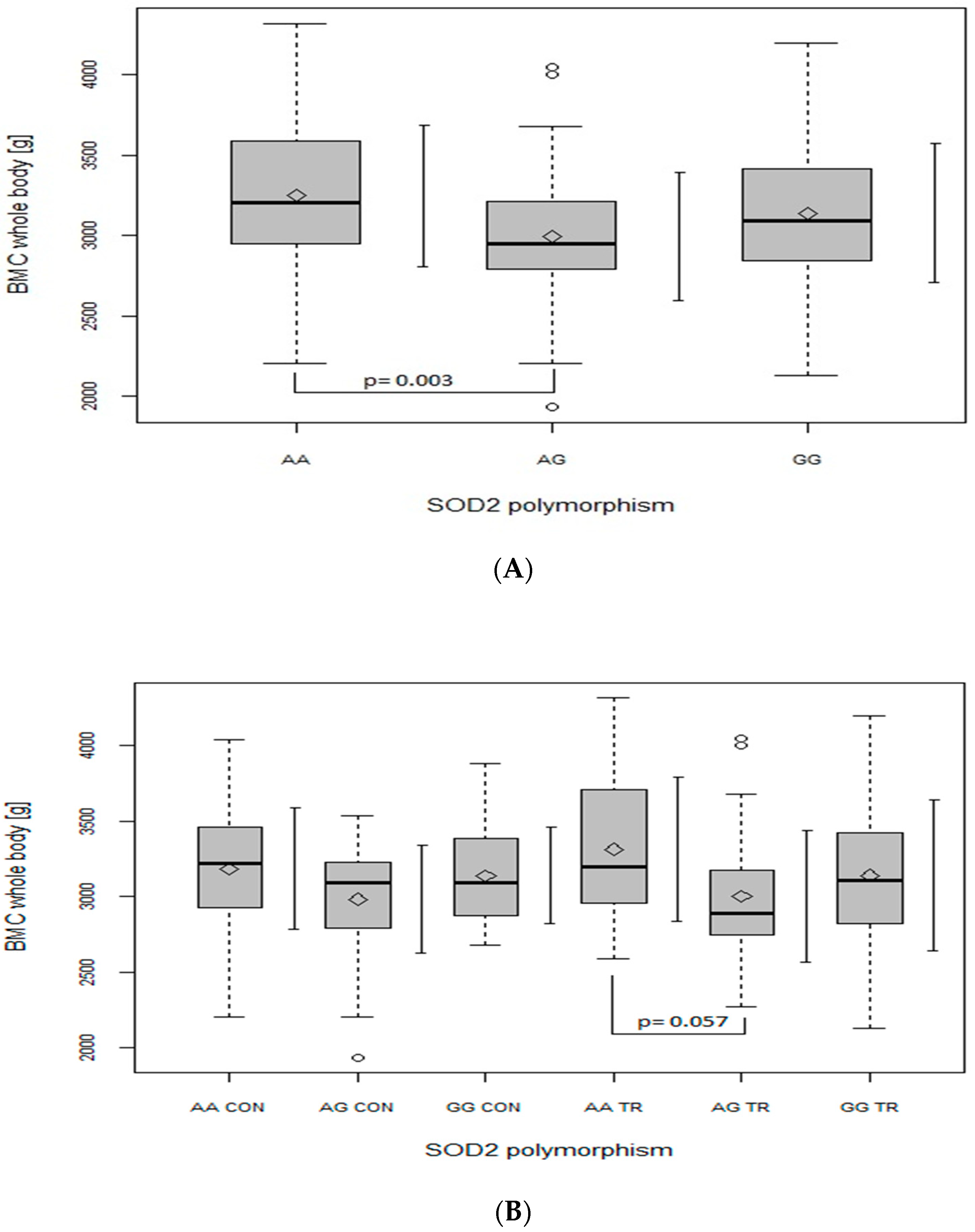
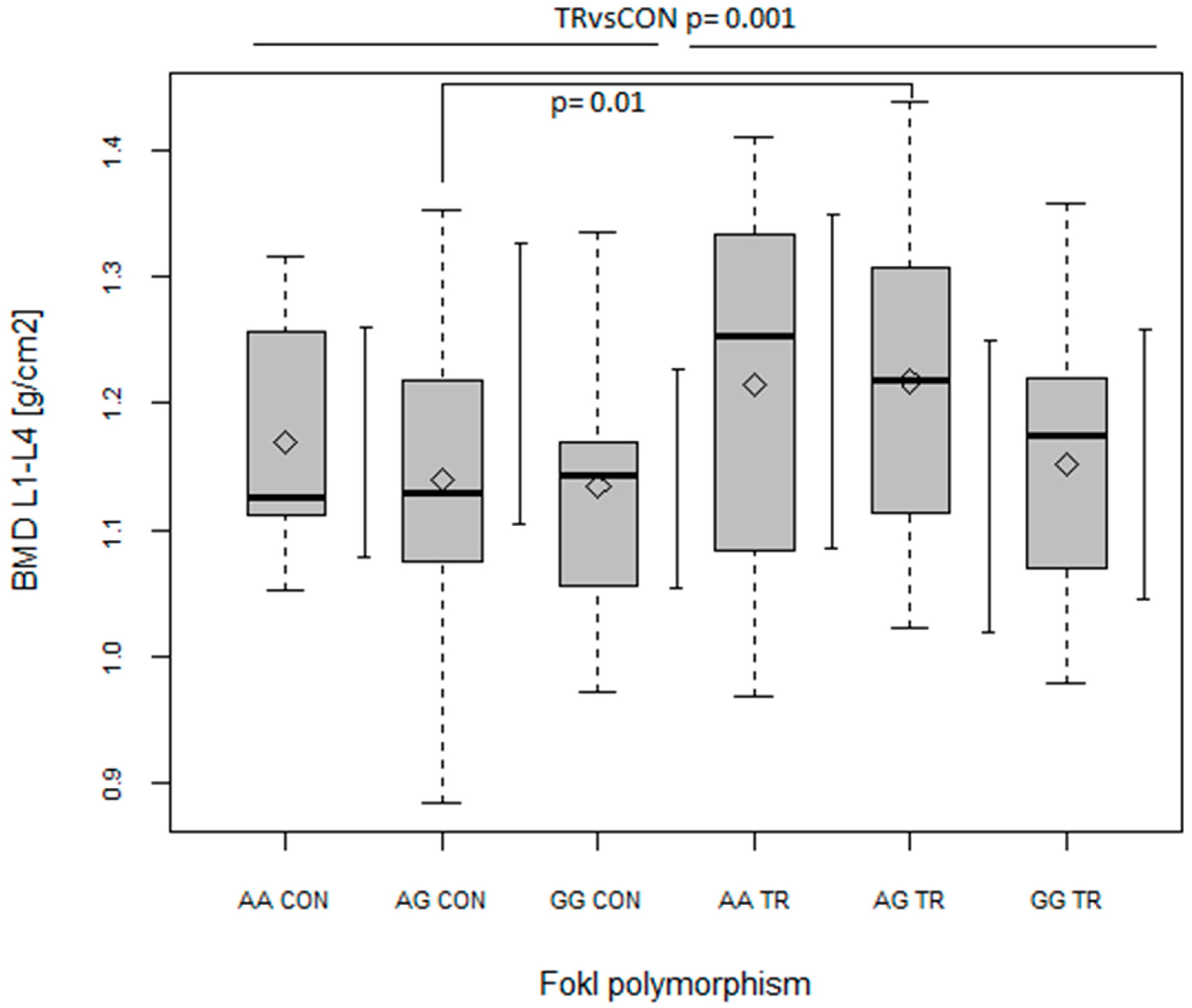
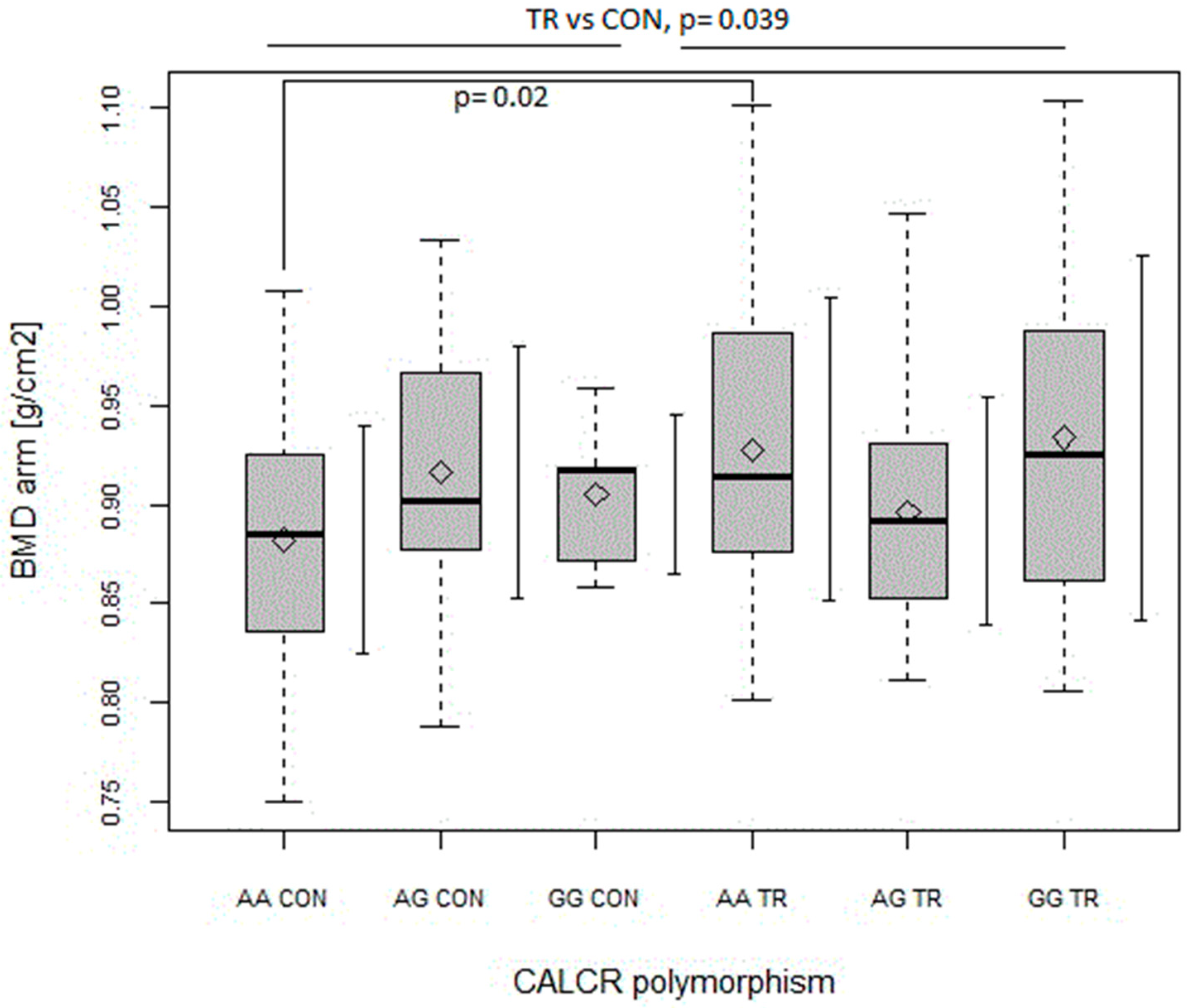
| CON (n = 87) | TR (n = 94) | ANOVA p-Value | ||
|---|---|---|---|---|
| Anthropometric data | age (years) | 21.18 ± 1.75 | 20.96 ± 2.26 | p = 0.48 |
| height (cm) | 182.28 ± 5.28 | 180.78 ± 8.16 | p = 0.16 | |
| body mass (kg) | 81.10 ± 9.73 | 80.38 ± 11.56 | p = 0.66 | |
| BMI (kg/m2) | 24.39 ± 2.56 | 24.54 ± 2.53 | p = 0.71 | |
| L1–L4 | BMC | 83.87 ± 11.04 | 92.20 ± 14.28 | p = 0.00004 |
| BMD | 1.14 ± 0.10 | 1.20 ± 0.12 | p = 0.0008 | |
| arm | BMC | 217.81 ± 29.50 | 219.73 ± 41.63 | p = 0.73 |
| BMD | 0.90 ± 0.06 | 0.92 ± 0.08 | p = 0.030 | |
| leg | BMC | 641.04 ± 89.14 | 648.96 ± 118.16 | p = 0.62 |
| BMD | 1.49 ± 0.15 | 1.54 ± 0.16 | p = 0.06 | |
| trunk | BMC | 2609.18 ± 337.41 | 2677.09 ± 463.92 | p = 0.28 |
| BMD | 1.21 ± 0.10 | 1.25 ± 0.11 | p = 0.025 | |
| whole body | BMC | 3079.59 ± 371.80 | 3123.20 ± 479.68 | p = 0.51 |
| BMD | 1.29 ± 0.10 | 1.31 ± 0.11 | p = 0.075 | |
| Z-score (min; max) | 1.01 ± 0.84 (−0.7; 2.8) | 1.31 ± 0.96 (−0.6; 3.6) | p = 0.027 | |
| T-score (min; max) | 0.93 ± 0.82 (−0.7; 2.8) | 1.17 ± 0.99 (−0.7; 3.5) | p = 0.076 |
| Variables | Reference Range | CON (n = 87) | TR (n = 94) | ANOVA p-Value |
|---|---|---|---|---|
| TAC [mmol/L] | 1.30–1.77 | 1.72 ± 0.18 | 1.64 ± 0.15 | p = 0.002 |
| GPx [U/g Hb] | 27.5–73.6 | 60.1 ± 26.1 | 63.8 ± 26.0 | p = 0.33 |
| SOD [U/g Hb] | 1102–1601 | 1507.4 ± 509.1 | 1518.7 ± 468.2 | p = 0.88 |
| LOOHs [µmol/L] | - | 3.06 ± 1.65 | 2.72 ± 1.79 | p = 0.17 |
| ALP [U/L] | 40–129 | 82.4 ± 23.5 | 76.9 ± 22.0 | p = 0.21 |
| Ca [mg/dL] | 8.60–10.30 | 8.05 ± 0.89 | 8.31 ± 0.53 | p = 0.11 |
| UA [mg/dL] | 3.40–7.00 | 5.55 ± 1.10 | 4.94 ± 0.96 | p = 0.0001 |
| P [mg/dL] | 2.60–4.50 | 3.67 ± 0.55 | 3.66 ± 0.82 | p = 0.92 |
| T [ng/mL] | 2.2–10.5 | 6.10 ± 1.45 | 5.86 ± 1.38 | p = 0.25 |
| OC [ng/mL] | <5.0 | 26.31 ± 10.01 | 24.26 ± 10.00 | p = 0.18 |
| 25-OH D [ng/mL] | 30–50 | 40.29 ± 28.11 | 36.18 ± 10.69 | p = 0.20 |
| Polymorphism | CON (n = 87) | TR (n = 94) | TR vs. CON |
|---|---|---|---|
| SOD1 A-39 C | χ2 = 0.18 p = 0.67 | ||
| AA | 78 (89.7) | 87 (92.5) | |
| AC | 9 (10.3) | 7 (7.5) | |
| CC | 0 | 0 | |
| HWE | p = 0.58 | p = 0.30 | |
| SOD2 Ala-9 Val | χ2 = 1.24 p = 0.54 | ||
| AA | 26 (29.9) | 23 (24.5) | |
| AG | 40 (46.0) | 42 (44.7) | |
| GG | 21 (24.1) | 29 (30.8) | |
| HWE | p = 0.57 | p = 0.40 | |
| GPx Pro198Leu | χ2 = 0.69 p = 0.40 | ||
| CC | 39 (44.8) | 49 (52.1) | |
| CT | 48 (55.2) | 45 (47.9) | |
| TT | 0 | 0 | |
| HWE | p = 0.0008 | p = 0.005 | |
| VDR ApaI | χ2 = 1.36 p = 0.51 | ||
| AA | 26 (29.9) | 23 (24.5) | |
| AC | 37 (42.5) | 48 (51.0) | |
| CC | 24 (27.6) | 23 (24.5) | |
| HWE | p = 0.22 | p = 0.94 | |
| VDR BsmI | χ2 = 2.21 p = 0.33 | ||
| AA | 16 (18.4) | 10 (10.7) | |
| AG | 35 (40.2) | 41 (43.6) | |
| GG | 36 (41.4) | 43 (45.7) | |
| HWE | p = 0.21 | p = 0.88 | |
| VDR FokI | χ2 = 1.45 p = 0.48 | ||
| AA | 15 (17.2) | 20 (21.3) | |
| AG | 44 (50.6) | 51 (54.2) | |
| GG | 28 (32.2) | 23 (24.5) | |
| HWE | p = 0.87 | p = 0.49 | |
| CALCR | χ2 = 11.57 p = 0.003 | ||
| AA | 44 (50.6) | 58 (61.7) | |
| AG | 38 (43.6) | 21 (22.3) | |
| GG | 5 (5.8) | 15 (16.0) | |
| HWE | p = 0.51 | p = 0.00006 | |
| COLIA1 | χ2 = 3.68 p = 0.16 | ||
| AA | 2 (2.3) | 8 (8.5) | |
| AC | 22 (25.3) | 19 (20.2) | |
| CC | 63 (72.4) | 67 (71.3) | |
| HWE | p = 0.74 | p = 0.52 |
| Response Variables | BMC L1–L4 (Std.Err.) | BMC Arm (Std.Err.) | BMC Leg (Std.Err.) | BMC Trunk (Std.Err.) | BMC Total (Std.Err.) | |
|---|---|---|---|---|---|---|
| Predictors | ||||||
| Age | 1.561 ** | 2.860 * | ||||
| (0.469) | (1.309) | |||||
| BMI | 5.864 *** | 12.547 *** | 51.801 *** | 60.093 *** | ||
| (1.000) | (2.969) | (11.369) | (12.106) | |||
| GPx CT | −3.727 * | |||||
| (1.831) | ||||||
| SOD2 AG | −5.299 * | −36.960 * | −153.853 * | −144.693 * | ||
| (2.208) | (16.191) | (63.413) | (67.997) | |||
| SOD2 GG | −0.746 | −8.323 | −57.214 | −23.763 | ||
| (2.456) | (18.066) | (70.974) | (75.905) | |||
| MMA | 6.897 * | |||||
| (3.270) | ||||||
| Soccer | 5.300 * | |||||
| (2.404) | ||||||
| Handball | 19.239 *** | 53.485 *** | 142.667 *** | 647.764 *** | 555.423 *** | |
| (3.914) | (10.099) | (28.281) | (113.529) | (117.715) | ||
| Wrestling | 14.187 *** | |||||
| (2.883) | ||||||
| R2 | 0.310 | 0.456 | 0.386 | 0.381 | 0.354 | |
| Adjusted R2 | 0.271 | 0.422 | 0.351 | 0.346 | 0.322 | |
| RSE | 11.522 | 29.223 | 84.699 | 332.110 | 356.180 | |
| F Statistic | 7.927 *** | 13.169 *** | 11.01 6*** | 10.806 *** | 10.909 *** | |
| Response Variables | BMD L1–L4 (Std.Err.) | BMD Arm (Std.Err.) | BMD Leg (Std.Err.) | BMD Trunk (Std.Err.) | BMD Total (Std.Err.) | |
|---|---|---|---|---|---|---|
| Predictors | ||||||
| TR vs. CON | 0.095 *** | 0.045 ** | ||||
| (0.025) | (0.016) | |||||
| Age | 0.006 * | 0.012 * | 0.008 * | 0.009 * | ||
| (0.002) | (0.006) | (0.004) | (0.004) | |||
| BMI | 0.011 *** | 0.011 *** | 0.014 ** | 0.011 *** | 0.012 *** | |
| (0.003) | (0.002) | (0.005) | (0.003) | (0.003) | ||
| FokI GG | −0.060 ** | −0.065 * | −0.052 * | −0.051 * | ||
| (0.022) | (0.031) | (0.021) | (0.021) | |||
| FokI AG | −0.020 | −0.037 | −0.026 | −0.026 | ||
| (0.020) | (0.028) | (0.019) | (0.019) | |||
| T | 0.012 ** | 0.011 ** | ||||
| (0.005) | (0.005) | |||||
| CALCR AG | 0.020 * | |||||
| (0.009) | ||||||
| CALCR GG | 0.009 | |||||
| (0.013) | ||||||
| OC | −0.004 *** | −0.002 ** | −0.002 ** | |||
| (0.001) | (0.001) | (0.001) | ||||
| MMA | 0.034* | |||||
| (0.015) | ||||||
| Soccer | ||||||
| Handball | 0.091 *** | 0.194 *** | 0.146 *** | 0.121 *** | ||
| (0.018) | (0.045) | (0.030) | (0.030) | |||
| Wrestling | 0.054 *** | 0.046* | ||||
| (0.014) | (0.024) | |||||
| R2 | 0.326 | 0.470 | 0.330 | 0.351 | 0.318 | |
| Adjusted R2 | 0.283 | 0.440 | 0.288 | 0.309 | 0.275 | |
| RSE | 0.097 | 0.053 | 0.133 | 0.089 | 0.089 | |
| F Statistic | 7.632 *** | 15.575 *** | 7.740 *** | 8.479 *** | 7.333 *** | |
Disclaimer/Publisher’s Note: The statements, opinions and data contained in all publications are solely those of the individual author(s) and contributor(s) and not of MDPI and/or the editor(s). MDPI and/or the editor(s) disclaim responsibility for any injury to people or property resulting from any ideas, methods, instructions or products referred to in the content. |
© 2023 by the authors. Licensee MDPI, Basel, Switzerland. This article is an open access article distributed under the terms and conditions of the Creative Commons Attribution (CC BY) license (https://creativecommons.org/licenses/by/4.0/).
Share and Cite
Jówko, E.; Długołęcka, B.; Cieśliński, I.; Kotowska, J. Polymorphisms in Genes Encoding VDR, CALCR and Antioxidant Enzymes as Predictors of Bone Tissue Condition in Young, Healthy Men. Int. J. Mol. Sci. 2023, 24, 3373. https://doi.org/10.3390/ijms24043373
Jówko E, Długołęcka B, Cieśliński I, Kotowska J. Polymorphisms in Genes Encoding VDR, CALCR and Antioxidant Enzymes as Predictors of Bone Tissue Condition in Young, Healthy Men. International Journal of Molecular Sciences. 2023; 24(4):3373. https://doi.org/10.3390/ijms24043373
Chicago/Turabian StyleJówko, Ewa, Barbara Długołęcka, Igor Cieśliński, and Jadwiga Kotowska. 2023. "Polymorphisms in Genes Encoding VDR, CALCR and Antioxidant Enzymes as Predictors of Bone Tissue Condition in Young, Healthy Men" International Journal of Molecular Sciences 24, no. 4: 3373. https://doi.org/10.3390/ijms24043373
APA StyleJówko, E., Długołęcka, B., Cieśliński, I., & Kotowska, J. (2023). Polymorphisms in Genes Encoding VDR, CALCR and Antioxidant Enzymes as Predictors of Bone Tissue Condition in Young, Healthy Men. International Journal of Molecular Sciences, 24(4), 3373. https://doi.org/10.3390/ijms24043373







